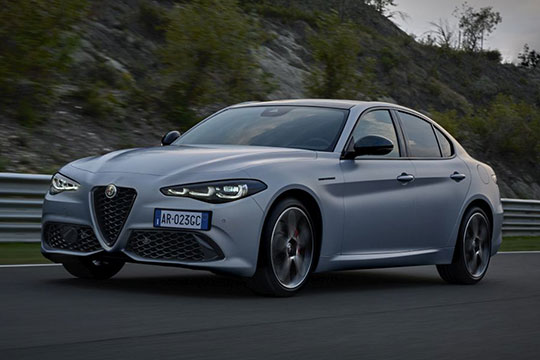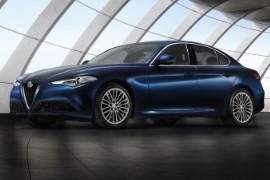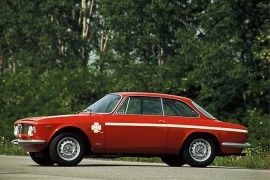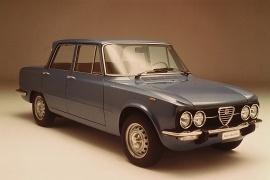ALFA ROMEO Giulia Models/Series Timeline, Specifications & Photos
First production year: 1962
Engines: Gasoline, Diesel
Alfa Romeo took the sports compact premium sedans by storm in 2015 when it introduced the Giulia, a car that took competitors by surprise and even made it across the ocean to the U.S. shores.
After failing to satisfy American customers back in the 90s, Alfa Romeo had to take a step back and focus on its European products. But when the new generation of the Giulia came on the market, it was time to cross the Atlantic ocean and roll its wheels onto American soil in 2015. But fast forward another seven years, and the Giulia received a new upgrade.
At the front, the "Trilobo" grille received a refresh, and the center triangle got a slimmer chromed trim. Also, it was shorter than the previous one, while the lower lobes were wider. Furthermore, the LED headlights sported angular-looking LED daytime running lights. At the back, the full LED taillights looked similar in shape but with a sharper lighting pattern. Last but not least, the Italian automaker included new light alloy wheels on the options list.
Inside, the most striking update was seen inside the instrument cluster, where a 12.3" TFT screen accessed all the vehicle information and parameters. In addition, the carmaker offered customization with three different layouts. Another unusual feature of the Giulia was the introduction of an NFT technology that could be included in the vehicle. This feature could keep track of vehicle's data and store it online using blockchain technology.
Under the skin, Alfa Romeo introduced a new 160 PS turbo-diesel version as a rear-wheel drive only affair, complementing the 210 PS turbo-diesel and the 280 PS turbocharged gasoline engine lineup.
The Giulia marked the return of the rear-wheel-drive sedans for the Italian car-maker. It was a complex program that led to a big change in its entire lineup. It was a true contender for the premium German cars.
Italian cars were all about styling. With some exceptions, all of them were well designed. Unfortunately, the change to the front-wheel-drive was a good idea for mas-market, but not a bright one for the premium segment. Alfa Romeo managed to revolutionize its range with the introduction of the 2016 Giulia.
The exterior design was one of its most important advantages. The big, triangular, shield in the front was accompanied by two lower-mounted grilles in the apron. With its „angry-eyes” looking headlights, narrow on the inside and swept-back over the front fenders inspired a dynamic design. From the side, the short and tall trunk, combined with the narrow front, inspired a sports-sedan vehicle. And that's what it was.
Inside, the Giulia offered one of the best-looking interiors in its class. It managed to incorporate the infotainment display next to the instrument cluster. It didn't look like an aftermarket tablet mounted over the center stack. The bucket-seats upfront promised good support while fast cornering. In the back, there was room for two adults in a comfortable position, or three if they were very close friends. The big transmission tunnel was intrusive in the cabin.
For the engine compartment, Alfa Romeo installed 2.0-liter gasoline or a 2.2-liter diesel engine. Both were turbocharged and were offered with a rear or all-wheel-drive. It was fitted with a 6-speed manual or an 8-speed automatic.
After the Giulietta era, when Alfa Romeo sold almost 180.000 units, the Italian carmaker made a successor for it, the Giulia.
Giulia was designed as a sporty sedan, but Autodelta, Alfa Romeo's motorsport department, understood that it might be an excellent race car and pushed the company to make it as a coupe. Bertone started to work and shortened Giulia's platform and designed a new bodywork for it, which barely resembled the sedan version.
The only parts that could resemble the sedan version were the headlights. Yet, in those times, most cars featured round headlamps. With its sloped shape and three-box sedan appearance, the Giulia Coupe was a good starting point for Autodelta to create a racing vehicle. It changed the body panels to aluminum, made the inner steel metallic parts thinner, and installed oversized dials for the speedometer and tachometer.
With its 2+2 construction and tall greenhouse, the Giulia Coupe could accommodate four occupants inside, separated by the transmission tunnel. Autodelta installed slim windows, and it replaced even the door handles with lighter alternatives. Thus, the Giulia GTA was born. While the GT stood for Grand Turismo, the A stood for "Alleggerita" (Lightened).
Under the hood, Alfa Romeo installed on a 1.3-liter engine developed by Autodelta from the larger 1.6-liter unit instead of working on the already existing 1.3-liter unit from the regular Giulia. The Italian engineers shortened the pistons' stroke and thus resulted in a rev-happy engine. They paired it to a 5-speed manual gearbox. As a result, the Giulia GTA 1300 Junior was a highly successful race car in its class.
The Italian automaker introduced the first generation of the Giulia in 1962, and, apart from its prestigious sibling Sprint Veloce, it also made it with a four-door sedan shape.
In those times, small engines ruled the European market, and the Italians were great at doing those kinds of powerplants. Moreover, the Giulia was not just a regular sedan; it was considered a premium compact vehicle, and, in addition, its performance took the car straight into the Italian Police garages, where it served long and well against the bad guys.
Its design didn't let anyone guess that the car was able to compete against many two-door coupes and sportscars. Its four headlights, the outer ones being bigger, flanked the center-mounted Alfa-shield that dominated the grille. Even though the Italian automaker made many aerodynamic-shaped cars, this one looked like a brick. Its wedged shapes and almost vertical windshield were in total contradiction with some of its siblings. Even its predecessor, the Giulietta Berlina, looked more streamlined. But that didn't really matter. It mattered that it looked modern for those years.
The cabin was fit for four adults with front bucket seats without headrests and a bench in the back where three passengers could hardly fit. Fortunately, thanks to the vertical side panels, there was enough shoulder and headroom. Depending on the version and trim levels, the automaker provided the vehicle with wood trims on the dash or just a mundane black plastic. Inside the instrument cluster, customers could find two large dials for the speedometer and tachometer, with the fuel gauge between them.
Under the hood, Alfa Romeo installed a 1.6-liter engine that produced, in its lowest-spec version, 92 PS (91 hp). Later, the automaker upgraded the powerplant with four Weber carburetors and produced 112 PS (110 hp). Also, in 1972, the automaker introduced a new base version powered by a 1.3-liter inline-four.



